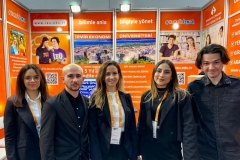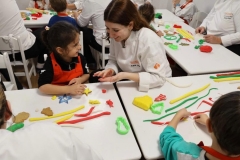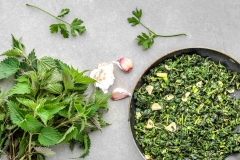
SCHOOL OF APPLIED MANAGEMENT SCIENCES
Gastronomy and Culinary Arts Program
CLM 301 | Course Introduction and Application Information
| Course Name |
Professional Skills Laboratory I
|
|
Code
|
Semester
|
Theory
(hour/week) |
Application/Lab
(hour/week) |
Local Credits
|
ECTS
|
|
CLM 301
|
Fall
|
2
|
6
|
5
|
6
|
| Prerequisites |
None
|
|||||
| Course Language |
English
|
|||||
| Course Type |
Required
|
|||||
| Course Level |
First Cycle
|
|||||
| Mode of Delivery | - | |||||
| Teaching Methods and Techniques of the Course | Application: Experiment / Laboratory / WorkshopLecture / Presentation | |||||
| Course Coordinator | - | |||||
| Course Lecturer(s) | ||||||
| Assistant(s) | - | |||||
| Course Objectives | The aim of this course is to develop the students' ability to present plates by preparing menus from world cuisines with appropriate cooking techniques. |
| Learning Outcomes |
The students who succeeded in this course;
|
| Course Description | In this course, students are taught the basic food service and the importance of teamwork in a professional kitchen environment. Within the scope of the course, students are provided to apply recipes, prepare for presentations and serve them to guests within the specified time. |
|
|
Core Courses | |
| Major Area Courses |
X
|
|
| Supportive Courses | ||
| Media and Management Skills Courses | ||
| Transferable Skill Courses |
WEEKLY SUBJECTS AND RELATED PREPARATION STUDIES
| Week | Subjects | Related Preparation |
| 1 | Introduction to the Course | |
| 2 | Theoretical: Staff Qualifications, Skills, and Knowledge / Application: Puree Soups, Dry Cooking Techniques (Pan-Frying), Pies and Tarts, Straight Dough Breads | Cousins, J., Lillicrap, D., & Weekes, S. “Food and Beverage Service”, Chap. 2: Staff Attributes, Skills and Knowledge, p. 27-54, 9th edn., London: Hodder Education, 2014. / Gisslen, W. “Professional Cooking”, Chap. 9: Soups, p. 225-266; Chap. 14: Cooking Methods for Meat, Poultry and Fish, p. 413-450, 8th edn., New York: John Wiley & Sons Inc., 2015. / Gisslen, W. “Professional Baking”, Chap. 7: Lean Yeast Doughs-Straight Doughs, p. 117-154; Chap. 15: Tarts and Special Pastries, p. 349-372; 7th edn., Hoboken: John Wiley & Sons Inc., 2017. |
| 3 | Theoretical: Table Preparation for Service - Service Equipment / Application: Puree Soups, Sous Vide Cooking Technique, Souffles and Dessert Sauces, Straight Dough Breads | Kotschevar, L. H., Luciani, V. “Presenting Service: The Ultimate Guide for Foodservice Professional”, Chap. 7: Classic Service Styles, p. 110-125, 2nd edn., Hoboken: John Wiley & Sons Inc., 2007. / Gisslen, W. “Professional Cooking”, Chap. 9: Soups, p. 225-266; Chap. 14: Cooking Methods for Meat, Poultry and Fish, p. 413-450, 8th edn., New York: John Wiley & Sons Inc., 2015. / Gisslen, W. “Professional Baking”, Chap. 7: Lean Yeast Doughs-Straight Doughs, p. 117-154; Chap. 19: Custards, Puddings, Mousses, and Souffles, p. 511-544; 7th edn., Hoboken: John Wiley & Sons Inc., 2017. |
| 4 | Theoretical: Service Techniques / Application: Clear Soups, Choux Pastry, Dry Cooking Techniques (Roasting), Custards and Puddings | Kotschevar, L. H., Luciani, V. “Presenting Service: The Ultimate Guide for Foodservice Professional”, Chap. 7: Classic Service Styles, p. 110-125, 2nd edn., Hoboken: John Wiley & Sons Inc., 2007. / Gisslen, W. “Professional Cooking”, Chap. 9: Soups, p. 225-266; Chap. 14: Cooking Methods for Meat, Poultry and Fish, p. 413-450, 8th edn., New York: John Wiley & Sons Inc., 2015. / Gisslen, W. “Professional Baking”, Chap. 7: Lean Yeast Doughs-Straight Doughs, p. 117-154; Chap. 14: Pastry Basics, p. 313-351; Chap. 19: Custards, Puddings, Mousses, and Souffles, p. 511-544; 7th edn., Hoboken: John Wiley & Sons Inc., 2017. |
| 5 | Theoretical: Sabores de Sefarad Event / Application: Sabores de Sefarad Event | Zafra, J. “Sabores de Sefarad: Los Secretos de la Gastronomia Judeoespanola”, p. 65-190, 3rd edn., Spain: Red de Juderias de Espana, 2021. |
| 6 | Theoretical: Factors Defining a Menu and Principles of Menu Item Selection / Application: Atatürk's Favorite Dishes | Traster, D. “Foundations of Menu Planning”, Chap. 1: Factors that Define a Menu, p. 1-11; Chap. 3: Menu Styles and Headings-Traditional Basics, p. 31-51, 2nd edn., New York: Pearson, 2018. |
| 7 | Theoretical: Traditional Menu Headings - Lunch and Dinner Menus / Application: Puree Soups, Moist Cooking Techniques (Boiling), Custards and Puddings, Sponge Breads | Traster, D. “Foundations of Menu Planning”, Chap. 3: Menu Styles and Headings-Traditional Basics, p. 31-51, 2nd edn., New York: Pearson, 2018. / Gisslen, W. “Professional Cooking”, Chap. 9: Soups, p. 225-266; Chap. 14: Cooking Methods for Meat, Poultry and Fish, p. 413-450, 8th edn., New York: John Wiley & Sons Inc., 2015. / Gisslen, W. “Professional Baking”, Chap. 8: Lean Yeast Doughs-Sponges, Pre-Ferments, and Sourdoughs, p. 164-182; Chap. 19: Custards, Puddings, Mousses, and Souffles, p. 511-544; 7th edn., Hoboken: John Wiley & Sons Inc., 2017. |
| 8 | Theoretical: Types of Menus / Application: Cream Soups, Combined Cooking Techniques (Braising), Fritters, Straight Dough Breads | Cousins, J., Lillicrap, D., & Weekes, S. “Food and Beverage Service”, Chap. 4: The Menu, Menu Knowledge and Accompaniments, p. 90-127, 9th edn., London: Hodder Education, 2014. / Gisslen, W. “Professional Cooking”, Chap. 9: Soups, p. 225-266; Chap. 14: Cooking Methods for Meat, Poultry and Fish, p. 413-450, 8th edn., New York: John Wiley & Sons Inc., 2015. / Gisslen, W. “Professional Baking”, Chap. 7: Lean Yeast Doughs-Straight Doughs, p. 117-154; Chap. 11: Doughnuts, Fritters, Pancakes, and Waffles, p. 232-253; 7th edn., Hoboken: John Wiley & Sons Inc., 2017. |
| 9 | Theoretical: Standardized Recipes / Application: Puree Soups, Moist Cooking Techniques (Poaching), Cakes and Dessert Sauces, Sponge Breads | Traster, D. “Foundations of Menu Planning”, Chap. 6: Standardized Recipes and Recipe Costing, p. 122-138, 2nd edn., New York: Pearson, 2018. / Gisslen, W. “Professional Cooking”, Chap. 9: Soups, p. 225-266; Chap. 14: Cooking Methods for Meat, Poultry and Fish, p. 413-450, 8th edn., New York: John Wiley & Sons Inc., 2015. / Gisslen, W. “Professional Baking”, Chap. 8: Lean Yeast Doughs-Sponges, Pre-Ferments, and Sourdoughs, p. 164-182; Chap. 16: Cake Mixing and Baking, p. 392-416; 7th edn., Hoboken: John Wiley & Sons Inc., 2017. |
| 10 | Theoretical: Menu Pricing / Application: Puree Soups, Salads, Dry Cooking Techniques (Shallow Frying), Puff Pastry Desserts | Traster, D. “Foundations of Menu Planning”, Chap. 6: Standardized Recipes and Recipe Costing, p. 122-138, 2nd edn., New York: Pearson, 2018. / Gisslen, W. “Professional Cooking”, Chap. 14: Cooking Methods for Meat, Poultry and Fish, p. 413-450; Chap. 21: Salad Dressings and Salads, p. 657-714, 8th edn., New York: John Wiley & Sons Inc., 2015. / Gisslen, W. “Professional Baking”, Chap. 14: Pastry Basics, p. 313-351, 7th edn., Hoboken: John Wiley & Sons Inc., 2017. |
| 11 | Midterm Exam | |
| 12 | Application: Specialty and National Soups, Starters, Combined Cooking Techniques (Stewing), Fruit Desserts / Project Submission | Gisslen, W. “Professional Cooking”, Chap. 9: Soups, p. 225-266; Chap. 14: Cooking Methods for Meat, Poultry and Fish, p. 413-450; Chap. 28: Pates, Terrines and Other Cold Foods, p. 849-876, 8th edn., New York: John Wiley & Sons Inc., 2015. / Gisslen, W. “Professional Baking”, Chap. 21: Fruit Desserts, p. 578-606, 7th edn., Hoboken: John Wiley & Sons Inc., 2017. |
| 13 | Application: Cream Soups, Dry Baking Techniques (Baking), Mousses, Quick Breads | Gisslen, W. “Professional Cooking”, Chap. 9: Soups, p. 225-266; Chap. 14: Cooking Methods for Meat, Poultry and Fish, p. 413-450, 8th edn., New York: John Wiley & Sons Inc., 2015. / Gisslen, W. “Professional Baking”, Chap. 10: Quick Breads, p. 216-231; Chap. 19: Custards, Puddings, Mousses, and Souffles, p. 511-544; 7th edn., Hoboken: John Wiley & Sons Inc., 2017. |
| 14 | Review of the semester | |
| 15 | Review of the Semester | |
| 16 | Final Exam |
| Course Notes/Textbooks | Lecture notes, slides and recipes Cousins, J., Lillicrap, D., & Weekes, S. “Food and Beverage Service”, 9th edn., London: Hodder Education, 2014. ISBN: 978-1-471-80795-4 Gisslen, W. “Professional Baking”, 7th edn., Hoboken: John Wiley & Sons Inc., 2017. ISBN: 978-1-119-14844-9 Gisslen, W. “Professional Cooking”, 8th edn., New York: John Wiley & Sons Inc, 2015. ISBN-13: 978-1-118-63672-5 Kotschevar, Lendal H., & Luciani, V. “Presenting Service: The Ultimate Guide for the Foodservice Professional”, 2nd edn., Hoboken, New Jersey: John Wiley & Sons Inc, 2007. ISBN-13: 978-0-471-47578 Traster, D. “Foundations of Menu Planning”, 2nd edn., New York: Pearson, 2017. ISBN-13: 978-0-13-448447-1 |
| Suggested Readings/Materials |
|
EVALUATION SYSTEM
| Semester Activities | Number | Weigthing |
| Participation | ||
| Laboratory / Application |
1
|
40
|
| Field Work | ||
| Quizzes / Studio Critiques | ||
| Portfolio | ||
| Homework / Assignments | ||
| Presentation / Jury | ||
| Project |
1
|
10
|
| Seminar / Workshop | ||
| Oral Exams | ||
| Midterm |
1
|
20
|
| Final Exam |
1
|
30
|
| Total |
| Weighting of Semester Activities on the Final Grade |
3
|
70
|
| Weighting of End-of-Semester Activities on the Final Grade |
1
|
30
|
| Total |
ECTS / WORKLOAD TABLE
| Semester Activities | Number | Duration (Hours) | Workload |
|---|---|---|---|
| Theoretical Course Hours (Including exam week: 16 x total hours) |
16
|
2
|
32
|
| Laboratory / Application Hours (Including exam week: '.16.' x total hours) |
16
|
6
|
96
|
| Study Hours Out of Class |
14
|
1
|
14
|
| Field Work |
0
|
||
| Quizzes / Studio Critiques |
0
|
||
| Portfolio |
0
|
||
| Homework / Assignments |
0
|
||
| Presentation / Jury |
0
|
||
| Project |
1
|
16
|
16
|
| Seminar / Workshop |
0
|
||
| Oral Exam |
0
|
||
| Midterms |
1
|
12
|
12
|
| Final Exam |
1
|
10
|
10
|
| Total |
180
|
COURSE LEARNING OUTCOMES AND PROGRAM QUALIFICATIONS RELATIONSHIP
|
#
|
Program Competencies/Outcomes |
* Contribution Level
|
||||
|
1
|
2
|
3
|
4
|
5
|
||
| 1 | Successfully applies theoretical and practical knowledge and skills in Gastronomy and Culinary Arts |
X | ||||
| 2 | Carries best practices in terms of work and food security, safety and hygiene in food production |
X | ||||
| 3 | Appreciates, evaluates and makes decisions regarding to visual, textual and nutritional data with respect to food production and presentation |
X | ||||
| 4 | Recognizes and evaluates the impact of gastronomy on culture and society |
|||||
| 5 | Assumes responsibility for solving complex problems that may occur in the field of Gastronomy and Culinary Arts, both individually and as a team member |
X | ||||
| 6 | Evaluates the knowledge and skills acquired in the field of Gastronomy and Culinary Arts with a critical approach and effectively communicate their ideas and suggestions for solutions in written and oral form. |
|||||
| 7 | Possesses necessary knowledge and skills in relevant fields such as gastronomy, design, law and management and effectively apply them to the practice of Culinary Arts |
|||||
| 8 | Uses the technological tools related to Gastronomy and Culinary Arts effectively |
X | ||||
| 9 | Updates and improve the knowledge, skills and competencies related to Gastronomy and Culinary Arts with lifelong learning awareness and sustainability with an ethical approach |
|||||
| 10 | Collects data in the areas of Gastronomy and Culinary Arts and communicate with colleagues in a foreign language. (European Language Portfolio Global Scale”, Level B1) |
|||||
| 11 | Speaks a second foreign at a medium level of fluency efficiently |
|||||
| 12 | Relates the knowledge gained through the history of humanity to the field of expertise |
|||||
*1 Lowest, 2 Low, 3 Average, 4 High, 5 Highest
NEWS |ALL NEWS

Aegean flavors from the chefs of the future
Izmir University of Economics (IUE) Department of Gastronomy and Culinary Arts left its mark on the 6th Izmir GastroFest, organized this year with
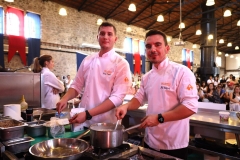
They added flavor to GURMEFEST
GURMEFEST, one of the biggest food, drink and entertainment festivals of Izmir, was ‘flavored’ with the dishes prepared and presented by the
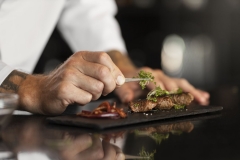
“Izmir and Bodrum will class up”
The MICHELIN Guide, one of the most prestigious restaurant rating systems in the world, has added Izmir and Bodrum to its Turkish
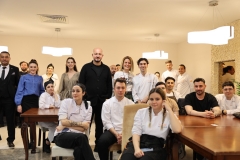
IUE graduates will prepare the flavors unique to Turkish cuisine
Bilsev Group, who is preparing to expand to Dubai this year with its Ferdi Baba, Fabrice Restaurant and Baba Pizza brands, will
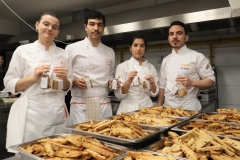
They prepared products that are filling and have a long shelf life
25 students of Department of Gastronomy and Culinary Arts of Izmir University of Economics (IUE) prepared products with a long shelf life,



